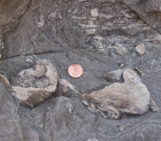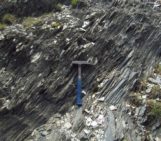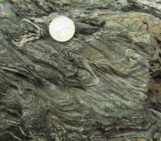
Orogens are the locus of intense deformation and metamorphism, mainly caused by convergent tectonics and burial. Yet, deeply buried rocks – metamorphosed at high pressure (HP) – are customarily met at the surface, even in “recent” systems such as the Alps. The long-standing question is naturally “how are these rocks brought back to the surface?” At the time John Platt wrote his manuscript (Platt, 1986), several ideas were already circulating in the community: rise of buoyant units through dense mantle rocks, HP blocks entrained by low-density large-scale diapirs, flow within so-called “tectonic mélanges”, regional uplift coupled to erosion… However, none of these reasons suffice to explain the large high-pressure tectonic units that were documented:
- Their densities are standard for continental material, and buoyancy alone cannot cause their exhumation;
- They show internally coherent metamorphic grades, that are likely not perturbed by deformation;
- Their exhumation ought to occur while convergence is still active, hence late- to post-orogenic deformation as reported for the Basin and Range is excluded;
- Their exhumation seems to predate extensive erosion, which implies that erosion is only a minor player;
- The units have sharp tectonic contacts with the lower-grade surrounding units.
The core idea of Platt (1986) builds from the extrapolation of the Coulomb wedge theory, initially defined for sedimentary units deforming in the plastic regime (Fig. 1), to greater depth, and at the scale of an orogenic wedge (highlighted by Armin Dielforder on Reddit). This involves a change in rheology, from brittle to ductile due to higher temperature (crystal plastic deformation), addition of fluids released by devolatilization reactions (clays to phyllosilicates), and, in general, lower rock yield strength.

Figure 1: Analogue modelling of underplating in an accretionary wedge where erosion promotes the exhumation of underthrusted units (from Malavieille and Konstantinovskaya, 2010).
In summary, an orogenic wedge grows by two mechanisms: accumulation of material at the front of the wedge (frontal accretion) and at the base of the wedge (underplating). And here is the key: units that were thrusted below the wedge, undergo HP-metamorphism, and get incorporated into the wedge (Fig. 1). This basal accretion sets the wedge unstable, leading to extension to reach stable conditions again, which is expressed in the wedge as extensional deformation. The continuous underplating of material thus implies a continuous exhumation of rocks from deeper levels as laterally continuous and coherent units. By this, Platt gives more weight to tectonics and wedge dynamics than to the initially proposed mechanisms such as erosion (e.g., Platt, 1975). To demonstrate the validity of the mechanism and its fitting to the geology, Platt brings the reader through several key examples: the Franciscan complex, the Alps, and the Betic cordilleras.
Of course, whereas the main driver is tectonics, several works subsequently demonstrated the interplay between tectonics and surface processes, and notably the effect of erosion that may enhance the exhumation of HP units in case of vigorous climatic conditions (e.g., Taïwan, Malavieille and Konstantinovskaya, 2010; Siame et al., 2011).

Figure 2: The importance of deviation form lithostatic pressure on the view we have on orogen dynamics (Tajčmanová et al., 2021)
A major question discussed on Reddit and still hotly debated in the community almost 40 years after Platt’s manuscript, is how to convert metamorphic pressure to depth, or in other words, “from how deep do rocks need to be exhumed?” The pressure recorded by metamorphic rocks is usually regarded as a linear relation with depth (lithostatic pressure), but caution is still needed when accounting for the variety of ways in which rocks are over-pressurized in orogens: retrieved peak pressure conditions may, in some cases, be recorded at shallower depths than usually considered (e.g., Luisier et al., 2019; Tajčmanová et al., 2021). Yet, the magnitude of overpressure and the recording capability of rocks are still to be properly constrained, and has the potential to change our view on orogens (Fig. 2)… We are definitely not yet done with orogens.
Written by Benoît Petri, Armin Dielforder, and David Fernández-Blanco, with the TS-mustread group.
References
Luisier, C., Baumgartner, L., Schmalholz, S.M., Siron, G., Vennemann, T., 2019. Metamorphic pressure variation in a coherent Alpine nappe challenges lithostatic pressure paradigm. Nat. Commun. 10, 4734. https://doi.org/10.1038/s41467-019-12727-z
Malavieille, J., Konstantinovskaya, E., 2010. Impact of surface processes on the growth of orogenic wedges: Insights from analog models and case studies. Geotectonics 44, 541–558. https://doi.org/10.1134/S0016852110060075
Platt, J.P., 1986. Dynamics of orogenic wedges and the uplift of high-pressure metamorphic rocks. Geol. Soc. Am. Bull. 97, 1037. https://doi.org/10.1130/0016-7606(1986)97<1037:DOOWAT>2.0.CO;2
Platt, J.P., 1975. Metamorphic and deformational processes in the Franciscan Complex, California: Some insights from the Catalina Schist terrane. Geol. Soc. Am. Bull. 86, 1337. https://doi.org/10.1130/0016-7606(1975)86<1337:MADPIT>2.0.CO;2
Siame, L.L., Angelier, J., Chen, R.-F., Godard, V., Derrieux, F., Bourlès, D.L., Braucher, R., Chang, K.-J., Chu, H.-T., Lee, J.-C., 2011. Erosion rates in an active orogen (NE-Taiwan): A confrontation of cosmogenic measurements with river suspended loads. Quat. Geochronol. 6, 246–260. https://doi.org/10.1016/j.quageo.2010.11.003
Tajčmanová, L., Manzotti, P, Alvaro M, 2021. Under Pressure: High-Pressure Metamorphism in the Alps, Elements, 17 (1): 17 – 22. https://doi.org/10.2138/gselements.17.1.17





Martin
Nice summary and discussion of a great article! Just one small notification, the reference for Tajčmanová et al., 2021 is missing.
Hannah Davies
Reference added, thanks for letting us know!